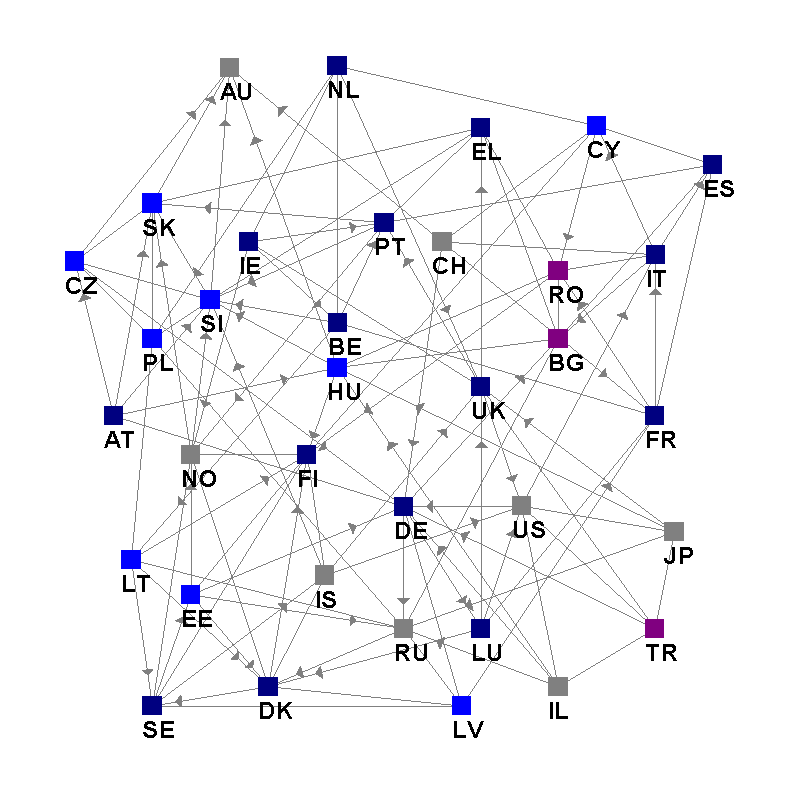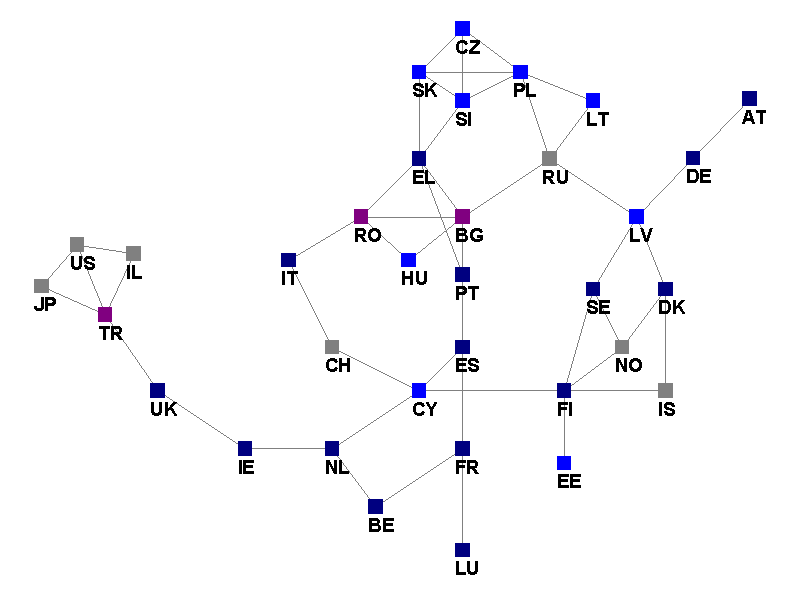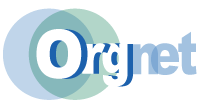|
|
Connecting Brains: Co-Publication Network of Scientists
European leaders met at the Lisbon Summit in 2000 and came away with a strategy to transform the European Union by 2010 into "the most competitive and dynamic knowledge based economy in the world capable of sustainable economic growth with more and better jobs and greater social cohesion." Europe is moving toward a knowledge society and part of that includes better coordination of research -- getting their scientists to talk to each other.
Scientific publications are often used as a gauge of scientific performance. Often these documents are written with one or more partners. When looking only at the volume of partnering amongst scientists, all European countries are linked to US, and Germany, while many are also linked to Great Britain and France because of the large number of available researchers in these four countries. Volume overwhelms the network -- connections happen with these countries because of the many researchers they have available to co-publish with. Yet, if we ignore the overwhelming volume of available co-authors from these four countries we see a more interesting pattern -- some of the small countries hold special places in the European research network.
We can focus on preferences rather than volume. Preferences are derived from the expected number of connections compared to the actual number of collaborations. Where the actual number of collaborations exceeds the expected number [given the population of researchers in each country] we show a preference for that partner. Although a small country like Slovenia does not participate in many co-publications because of its limited pool of scientists, it is chosen as a preferred partner by several large countries.
What makes a preferred co-author? A combination of human capital [what the researcher knows and has experienced] and social capital [what people, knowledge and resources the researcher has access to]. A country's preference for another country as a research partner is built up of multiple cross-border relationships between individual scientists. It is the sum of the 'connected brains' that determine the link between two countries.
When mapping all of the research partner preferences we do not see a clear pattern. The directional links in the network show which country prefers to work with which others. 'Country X prefers country Y as a research collaboration partner' is drawn as X --> Y.

Who are the most preferred partners? Visually it is hard to tell. We run some network metrics. As Google can show key web pages based on who links to them, we can show key countries based on the aggregated preferences of all countries. Using terms from The Tipping Point we see the key players revealed by the network metrics.
- Connectors - Germany and Finland
- Mavens - Slovenia and Finland, followed by Russia
These findings are on one hand expected -- Germany and Finland, and on the other hand, a surprise -- Slovenia and Russia. Connectors are nodes in a network that link the unconnected. Mavens are those nodes in that that people seek out for knowledge and expertise. In calculating the network metrics we use both direct and indirect ties between the nodes.
In some instances two countries prefer to work with each other, in others the preference is one-sided -- a common occurrence in human affairs. Where two countries prefer to work with each other the tie between them is stronger -- revealing mutual attraction. The network map showing two-way links of preference [below] is sparser and shows some expected pairings and clusters. Many of the pairings in this network map reveal a geographical bias -- those close by, form a tie.

One of the surprises on this chart of stronger preferences is the appearance of United States, United Kingdom, Germany and France on the periphery of the network. When looking at the total volume of co-publications these four countries dominate because of their large available research communities for others to partner with. But when factoring out their size, they do not end up in pairings of mutual choice. How can Germany be a key player in the first network and on the periphery in this subset of data? Germany often chooses new partners that it does not already have a relationship with -- allowing it to be 'between' many pairs of others who do not have a direct connection.
A lesser surprise is the sparseness of this network. The structural holes in the network [places without connections], create opportunities for new ties. Often when two distant nodes connect in a network, it brings the whole network closer together by reducing the average path length between all network nodes -- not just the two who are connecting. These shorter paths help information and knowledge move around the network and also create an increased awareness of what is happening throughout the network -- in other parts, where one does not have direct ties.
An effective economic network often takes the shape of a core-periphery structure [PDF]. The core is a densely connected inner cluster that has trusted ties for working together, while the periphery reaches out to other clusters to bring in new, diverse information and knowledge. The core gets things done while the periphery creates opportunities for learning and innovation. The European research community can build both a denser core, and find new peripheral opportunities in the remaining years to 2010. Both a solid core and wide reaching periphery are necessary for an agile and adaptive network that learns and innovates rapidly.
Data Source: Key Figures 2003-2004: Towards a European Research Area - Science, Technology and Innovation
Software and Training in social network analysis are available from the author.
Copyright © 2005, Valdis Krebs
